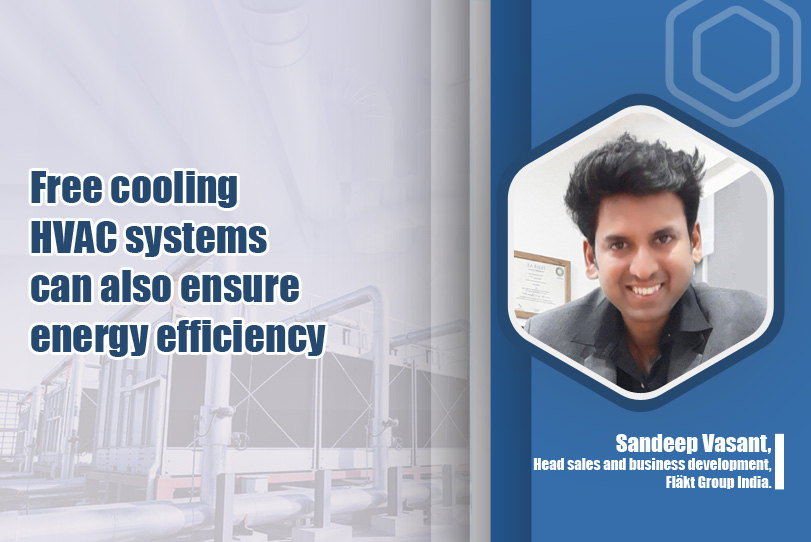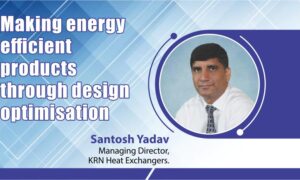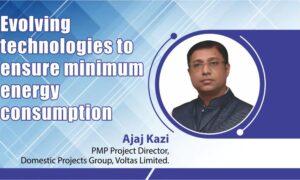To ensure energy efficiency, we need to design the right cooling solution for large buildings that have chillers and fans.
The entire focus is on energy efficiency. Sustainability means meeting our own needs without compromising the ability of future generations. India has taken the pledge at COP26 that we call net zero emission by 2070. I am sure all of us should take that pledge and drive towards what are the action plans. I will talk about free cooling reuse, reduce recycle, and rainwater harvesting. The studies conducted in every home indicate if buildings or workstations do rain for harvesting at every home, we will have enough rain for our future generation. But in the current situation we have a rain problem and water problem in every household. So rainwater harvesting should be done by every one of us.
Net Zero
Net zero energy building, net zero emissions, zero waste. So let’s take the pledge of net zero sustainability at the home we stay, and also at the office in the factory. I would like to quote what Gandhiji said, that the earth provides enough to satisfy every man’s need, but not any man’s greed. Why are we talking about sustainability? Because according to recent reports, by 2050, 685 million people in 576 cities could face a 10 percent decrease in freshwater. That’s like an astonishing number. But before that we need to get into net zero emission Net Zero building and sustainability. So with those double important studies, let’s get into the agenda.
Cooling equipment
What’s very important as we purchase any cooling equipment is the energy efficiency ratio which basically defines the power consumption by the equipment. Again, there is an ASHRAE norm which stays in a data centre where the major power consumption apart from the IT is taken away by HVAC cooling. So, it’s a concern and we need to design the right solution.
Then we have humidity, vibration and dust factors. Further, the report says that if you don’t design the right cooling unit, due to a human failure or a human error, the entire system can be down. So, we need to design the right solution. Cooling is taking very close to 23 percent of the global warming. So, all the studies and reports say that we need to kind of design the right cooling solution when we talk on large buildings that have chillers and fans. You have the fans and the pumps in the HVAC building, the moment you go for a water cooled chiller the power consumption or rather the total power consumption taken away by the cooling tower is close to 50 to 60 percent.
What HVAC system is for the benefit of everyone, cooling your equipment, comfort cooling or be it the VRV? Also there is a unit called cruise control unit which is also called as a precision air conditioning unit, which are kind of to precisely control the temperature and the RH in the plus or minus one the temperature and average in the range of plus or minus five for any critical and high sensible application to this to give you a flavour of different HVAC system. It’s very important that you select the inverter variable compressor. We had R22, now we are talking about HFO; very important that we select green gas. And as you select any of the HVAC systems, or if you’re selecting a normal split AC at home please see that you select the best star rating.
ASHRAE norms clearly define the supply air temperature to be between 18 to 27. So what happens is that as you operate, this is a supplier temperature. You could see the cooling capacity of any HVAC system like a PAC and other would slightly increase and the power consumption would decrease close to 40 to 50 percent it is the saving on the unit per day.
Not only that, if you look at these are the day one a two and a four category from the ASHRAE norms specifically for the data centre not only on the temperature also there is a clear differentiation of the average to be maintained but such critical cooling such as data centre, apart from data centre name any commercial building and the current pandemic and we’re talking about the new virus with the COVID there is a clear ISHRAE guideline. So we spoke on the temperature so it’s very important that we operate that 18 to 27 and operate any HVAC or AHU in these gradients to get a better lower power consumption.
With this concept we are talking about free cooling because free cooling is cooling the space with the free ambient air keeping in mind of the energy sustainability and the free cold air which is very much important in line with our ASHRAE norms for data centre and ISHRAE norms comfort application.
Different types of free cooling Yes, there are direct and indirect. Fresh Air, kind of makes you more energetic and then cleans away the harmful diseases which are there including the Covid so fresh air is a top of the town and free cooling is something which we’ve been talking about in the last one or two years in the HVAC system. So there are different climatic temperatures in a place like India. So you could see there is hot and dry, warm humid composite and there are different temperatures.
For a data centre there is a document for everything within the ASHRAE. As long as you’re circulating the air without the fresh air, you could use the filter if the outside air contains the contaminated air coming inside.
You could look at – view the outside air comes inside the space but the outside air would also have a couple of features of the dust, smoke and airborne particles that is we use the filtration through the AHU. So, we don’t want the bad air to come inside the space. So, we do have filtration which can be used for the site requirement and the location. Again, what we have different filtration is the pressure according to the increase. So, again depending upon the application and the type of the return location different filters can be used specifically in a data centre, we are more worried about the outside contaminated air, again there is an ASHRAE norm, which talks about the particle limit which will not arm the server blades.
You could look at free cooling before switching off the fans which re-circulate until the temperature increases. So, with that I want to go to the end. In the indirect free cooling we had the contaminated air coming inside. But in the indirect free cooling we use the advantage of lower ambient but the dust and the particle does not enter the space.
When I say free cooling circuit not connected to the chiller just a circulation of water and ethylene glycol connected to the dry cooler as the ambient kind is very low, it operates only in the free cooling; no compressor, no condenser will be the free cooling with the pump. As the ambient temperature increases, it gradually goes from free cooling to a mixed mode.
Let’s say if you’re looking at a large commercial building or a large data centre, you would want a larger handling unit. These units would also have an air washer or an adiabatic cooling pad which would kind of spray water again; this is an indirect cooling unit for a larger application of larger capacity. These units would also have a compressor with a damper opening and closing to cool the compressor which can be connected with the compressor, or even the chilled water unit. Depending upon the application site and usage the airflow would be cross airflow depending upon the application it can be floor mounted or terrace mounted, you will see as I talk the compressor cooling which is on, it can also be connected with the Chiller, you could see the hot air which is the return air from the room and the cold air going back to the room. So, this is the indirect evaporative cooling you could see the temperature gradient falling from a 42-27, which is quite massive in terms of the drop and 30 is what we saw initially and this would kind of meet our number and type of type of meeting the temperature requirement in the room.
Again as an emerging trend on the cooling unit PAC or AHU we have a couple of sites in India where one circuit is connected to the chiller and another. So, you have a free cooling water circulation within the plate exchanger and the cooling system. So if you see the temperature, you can drop up to 27, close to 63 percent. To add to that, to ISHRAE and ASHRAE norms, higher temperature would also mean higher chilled water temperature 22-27. With that concept, you would have a good saving close to 50 percent saving, and with that running chilled water supply temperature you could eliminate the chiller and use a plated exchanger which is a free cooling unit, you will have a different heat exchanger as well within the chiller.
Adiabatic pad is a free cooling chiller. So a combination of economiser and the water side economiser would give you the best bet on free cooling. Let us ensure energy efficiency as we design any HVAC system with that.
Cookie Consent
We use cookies to personalize your experience. By continuing to visit this website you agree to our Terms & Conditions, Privacy Policy and Cookie Policy.














